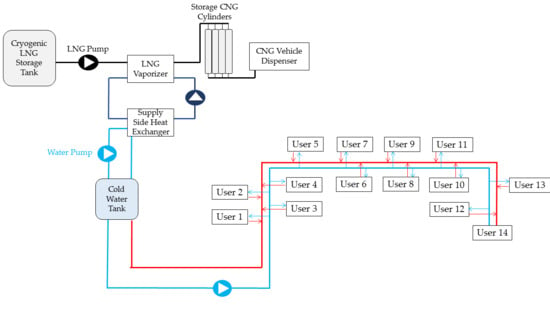Potential of District Cooling Systems: A Case Study on Recovering Cold Energy from Liquefied Natural Gas Vaporization
Abstract
1. Introduction
2. Case Study
2.1. L–CNG Cold Supply Side
2.2. Residential District Model
2.2.1. Single User
2.2.2. DCS Plant Sizing
3. Results and Discussion
4. Conclusions
Author Contributions
Funding
Conflicts of Interest
Nomenclature
| BAT | Best available technology |
| CNG | Compressed natural gas |
| DCS | District cooling system |
| EU | European Union |
| FCU | Fan coil unit |
| HP | Heat pump |
| L–CNG | Liquid to compressed natural gas |
| LNG | Liquefied natural gas |
| P | Cooling power profile |
| PCM | Phase change material |
| RES | Renewable energy source |
| SETIS | Strategic Energy Technologies Information System |
| SFH | Single-family house |
| TES | Thermal energy storage |
References
- Mazzarella, L. Energy retrofit of historic and existing buildings. The legislative and regulatory point of view. Energy Build. 2015, 95, 23–31. [Google Scholar] [CrossRef]
- Jakubcionis, M.; Carlsson, J. Estimation of European Union residential sector space cooling potential. Energy Policy 2017, 101, 225–235. [Google Scholar] [CrossRef]
- Passerini, F.; Sterling, R.; Keane, M.; Klobut, K.; Costa, A. Energy efficiency facets: Innovative district cooling systems. Entrepreneurship Sustain. Issues 2017, 4, 310–318. [Google Scholar] [CrossRef]
- Frederiksen, S.; Werner, S. District Heating and Cooling; Studentlitteratur: Lund, Sweden, 2013; Volume 579. [Google Scholar]
- Dominković, D.F.; Rashid, K.B.A.; Romagnoli, A.; Pedersen, A.S.; Leong, K.C.; Krajačić, G.; Duić, N. Potential of district cooling in hot and humid climates. Appl. Energy 2017, 208, 49–61. [Google Scholar] [CrossRef]
- Chiam, Z.; Easwaran, A.; Mouquet, D.; Fazlollahi, S.; Millás, J.V. A hierarchical framework for holistic optimization of the operations of district cooling systems. Appl. Energy 2019, 239, 23–40. [Google Scholar] [CrossRef]
- Vandermeulen, A.; van der Heijde, B.; Helsen, L. Controlling district heating and cooling networks to unlock flexibility: A review. Energy 2018, 151, 103–115. [Google Scholar] [CrossRef]
- Energy Efficiency Directive. Available online: https://ec.europa.eu/energy/en/topics/energy-efficiency/energy-efficiency-directive (accessed on 19 June 2019).
- Strategic Energy Technologies Information System. Available online: https://setis.ec.europa.eu/ (accessed on 19 June 2019).
- Connolly, D.; Lund, H.; Mathiesen, B.V.; Werner, S.; Möller, B.; Persson, U.; Nielsen, S. Heat Roadmap Europe: Combining district heating with heat savings to decarbonise the EU energy system. Energy Policy 2014, 65, 475–489. [Google Scholar] [CrossRef]
- David, A.; Mathiesen, B.V.; Averfalk, H.; Werner, S.; Lund, H. Heat Roadmap Europe: Large-scale electric heat pumps in district heating systems. Energies 2017, 10, 578. [Google Scholar] [CrossRef]
- Werner, S. International review of district heating and cooling. Energy 2017, 137, 617–631. [Google Scholar] [CrossRef]
- Gang, W.; Wang, S.; Xiao, F.; Gao, D.C. District cooling systems: Technology integration, system optimization, challenges and opportunities for applications. Renew. Sustain. Energy Rev. 2016, 53, 253–264. [Google Scholar] [CrossRef]
- Buonomano, A.; Calise, F.; Ferruzzi, G.; Vanoli, L. A novel renewable polygeneration system for hospital buildings: Design, simulation and thermo-economic optimization. Appl. Therm. Eng. 2014, 67, 43–60. [Google Scholar] [CrossRef]
- Lee, K.S. A review on concepts, applications, and models of aquifer thermal energy storage systems. Energies 2010, 3, 1320–1334. [Google Scholar] [CrossRef]
- Paksoy, H.O.; Andersson, O.; Abaci, S.; Evliya, H.; Turgut, B. Heating and cooling of a hospital using solar energy coupled with seasonal thermal energy storage in an aquifer. Renew. Energy 2000, 19, 117–122. [Google Scholar] [CrossRef]
- Udomsri, S.; Martin, A.R.; Martin, V. Thermally driven cooling coupled with municipal solid waste-fired power plant: Application of combined heat, cooling and power in tropical urban areas. Appl. Energy 2011, 88, 1532–1542. [Google Scholar] [CrossRef]
- Shu, H.; Duanmu, L.; Zhang, C.; Zhu, Y. Study on the decision-making of district cooling and heating systems by means of value engineering. Renew. Energy 2010, 35, 1929–1939. [Google Scholar] [CrossRef]
- Chow, T.T.; Au, W.H.; Yau, R.; Cheng, V.; Chan, A.; Fong, K.F. Applying district-cooling technology in Hong Kong. Appl. Energy 2014, 79, 275–289. [Google Scholar] [CrossRef]
- Poeuf, P.; Senejean, B.; Ladaurade, C. District cooling system: The most efficient system for urban applications. In Proceedings of the Sustainable Refrigeration and Heat Pump Technology Conference, Stockholm, Sweden, 13–16 June 2010. [Google Scholar]
- Zogg, R.; Roth, K.; Brodrick, J. Lake-source district cooling systems. ASHRAE J. 2008, 50, 55–57. [Google Scholar]
- Reverberi, A.; Borghi, A.D.; Dovì, V. Optimal design of cogeneration systems in industrial plants combined with district heating/cooling and underground thermal energy storage. Energies 2011, 4, 2151–2165. [Google Scholar] [CrossRef]
- Kabalina, N.; Costa, M.; Yang, W.; Martin, A. Production of Synthetic Natural Gas from Refuse-Derived Fuel Gasification for Use in a Polygeneration District Heating and Cooling System. Energies 2016, 9, 1080. [Google Scholar] [CrossRef]
- He, T.; Chong, Z.R.; Zheng, J.; Ju, Y.; Linga, P. LNG cold energy utilization: Prospects and challenges. Energy 2019, 170, 557–568. [Google Scholar] [CrossRef]
- He, T.; Karimi, I.A.; Ju, Y. Review on the design and optimization of natural gas liquefaction processes for onshore and offshore applications. Chem. Eng. Res. Des. 2018, 132, 89–114. [Google Scholar] [CrossRef]
- Franco, A.; Casarosa, C. Thermodynamic and heat transfer analysis of LNG energy recovery for power production. J. Phys. Conf. Ser. 2014. [Google Scholar] [CrossRef]
- Arteconi, A.; Polonara, F. LNG as vehicle fuel and the problem of supply: The Italian case study. Energy Policy 2013, 62, 503–512. [Google Scholar] [CrossRef]
- Heisch, P. Liquefied to Compressed Natural Gas Opportunities and Strategies. In Proceedings of the GasShow Exhibition and Conference, Warsaw, Poland, 7–8 March 2012. [Google Scholar]
- REF-E and SSLNG Watch. Monitoring of the LNG Final Uses Market in Italy; Intermediate Report; First half: Vancouver, BC, Canada, 2019. [Google Scholar]
- ConferenzaGNL. New LNG Stations: Q8 in Bergamo, Snam-Tamoil Agreement, ENI Commitments. (Nuove Stazioni GNL: Q8 a Bergamo, Accordo Snam-Tamoil, Impegni ENI). Available online: http://www.conferenzagnl.com/nuove-stazioni-gnl-q8-snam-tamoil-eni/ (accessed on 29 July 2019).
- Franci, T. The prospects for the Italian LNG end-use market in Italy. In Proceedings of the ExpoGNL, Napoli, Italy, 10–11 May 2017. [Google Scholar]
- Farzaneh-Gord, M.; Saadat-Targhi, M.; Khadem, J. Selecting optimal volume ratio of reservoir tanks in CNG refueling station with multi-line storage system. Int. J. Hydrog. Energy 2016, 41, 23109–23119. [Google Scholar] [CrossRef]
- Klein, S.; Beckman, A.; Mitchell, W.; Duffie, A. TRNSYS 17-A TRansient SYstems Simulation Program; Solar Energy Laboratory, University of Wisconsin: Madison, WI, USA, 2011. [Google Scholar]
- Corrado, V.; Ballarini, I.; Corgnati, S.P.; Talà, N. Building Typology Brochure–Italy. In Fascicolo sulla Tipologia Edilizia Italiana; Politecnico di Torino, Dipartimento di Energia: Turin, Italy, 2011; pp. 1–117. [Google Scholar]
- UNI (Ente Italiano di Unificazione). Energy Performance of Buildings. Part 1: Evaluation of Energy Need for Space Heating and Cooling; UNI/TS 11300-1; UNI: Milan, Italy, 2014. [Google Scholar]
- UNI (Ente Italiano di Unificazione). Ergonomics of the Thermal Environment—Analytical Determination and Interpretation of Thermal Comfort Using Calculation of the PMV and PPD Indices and Local Thermal Comfort Criteria. ICS 13.180; UNI EN ISO 7730:2006; UNI: Milan, Italy, 2006. [Google Scholar]
- Pizzetti, C. Condizionamento Dell’aria e Refrigerazione; Ambrosiana: Milano, Italy, 2012; Volume 1 e2. [Google Scholar]
- American Society of Heating, Refrigerating and Air-Conditioning Engineers (ASHRAE). ASHRAE Handbook Fundamentals; 1791 Tullie Circle, N.E.: Atlanta, GA, USA, 2005. [Google Scholar]
- UNI (Ente Italiano di Unificazione). Heating and Cooling of Buildings-Climatic Data-Part 2: Data for Design Load; UNI/TR 10349-2; UNI: Milan, Italy, 2016. [Google Scholar]
- Doninelli, M. I Circuiti e i Terminali Degli Impianti di Climatizzazione (the Circuits and the Terminals of the Air Conditioning Systems). Qauderni Caleffi. Available online: https://www.caleffi.com/sites/default/files/file/quaderno_2_it.pdf (accessed on 29 July 2019).
- Viessmann. Air to Water Heat Pump with DC Inverter Technology for Heating and Cooling; VITOCAL 200-S; Viessmann: Allendorf, Germany, 2010. [Google Scholar]
- System with Pre-Insulated Pipes for District Heating & Cooling (DHC). Version 01. May 2014. Available online: http://www.etasuisse.com/assets/Etasuisse%20AG%20-%20Isotechnik%20Katalog%20EN.pdf (accessed on 5 August 2019).
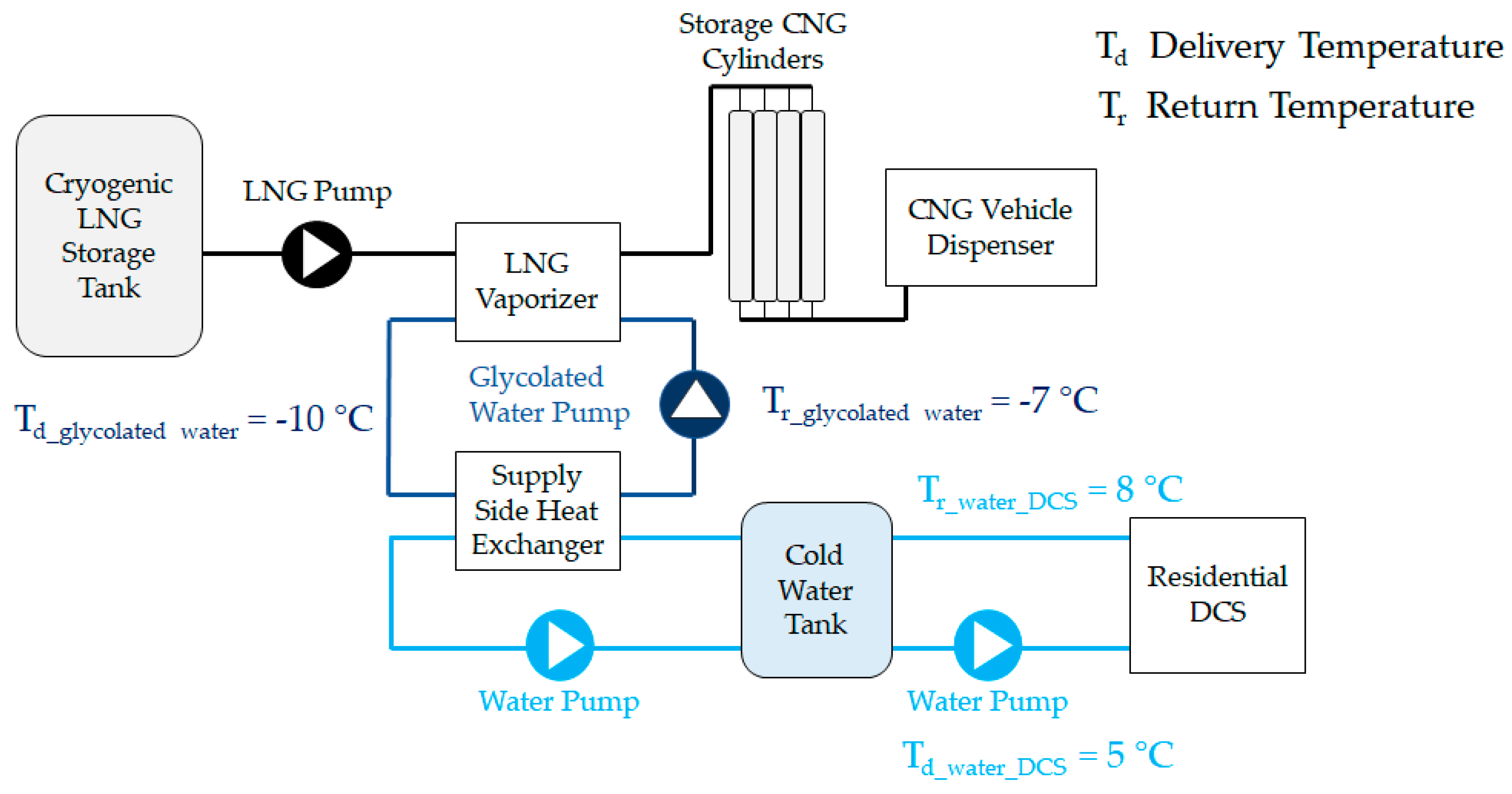

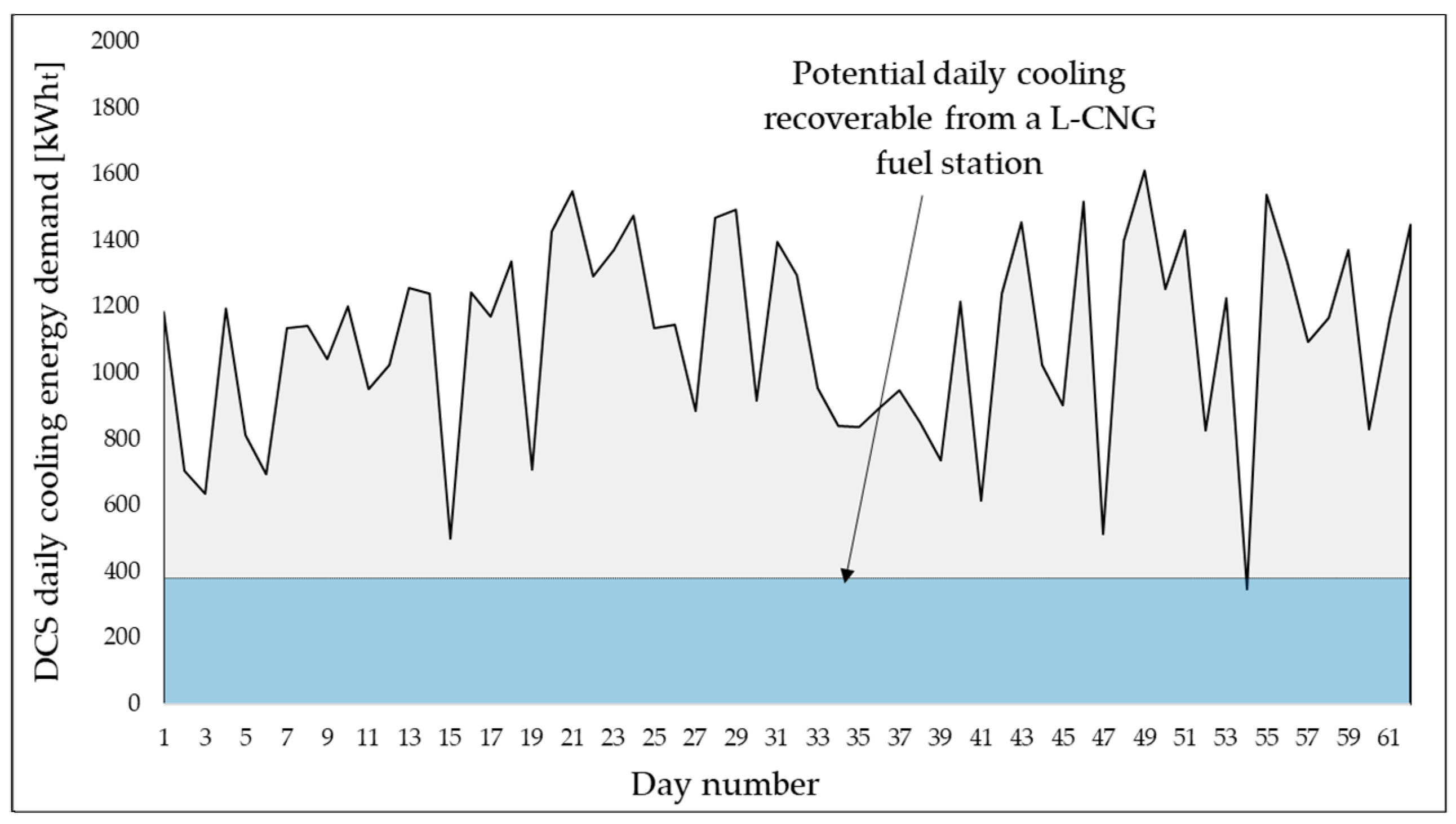
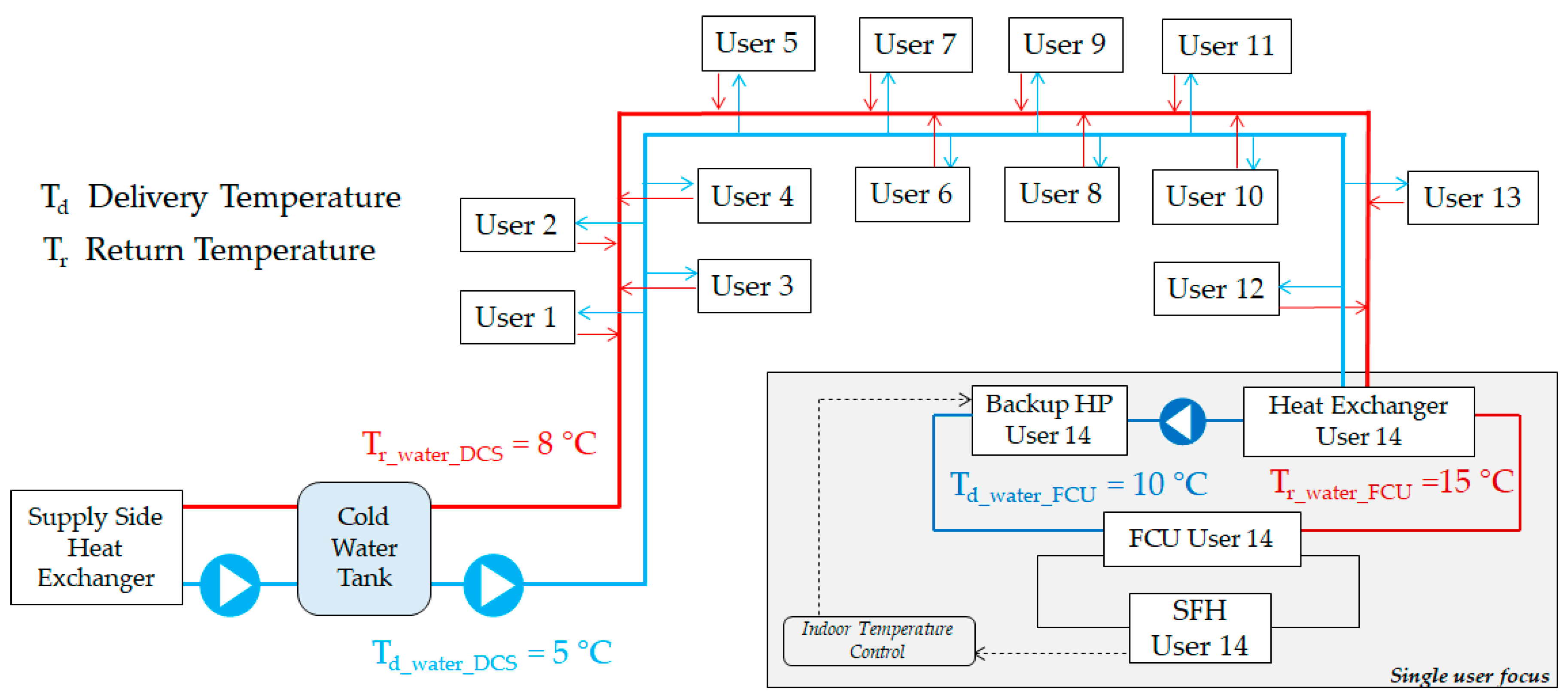


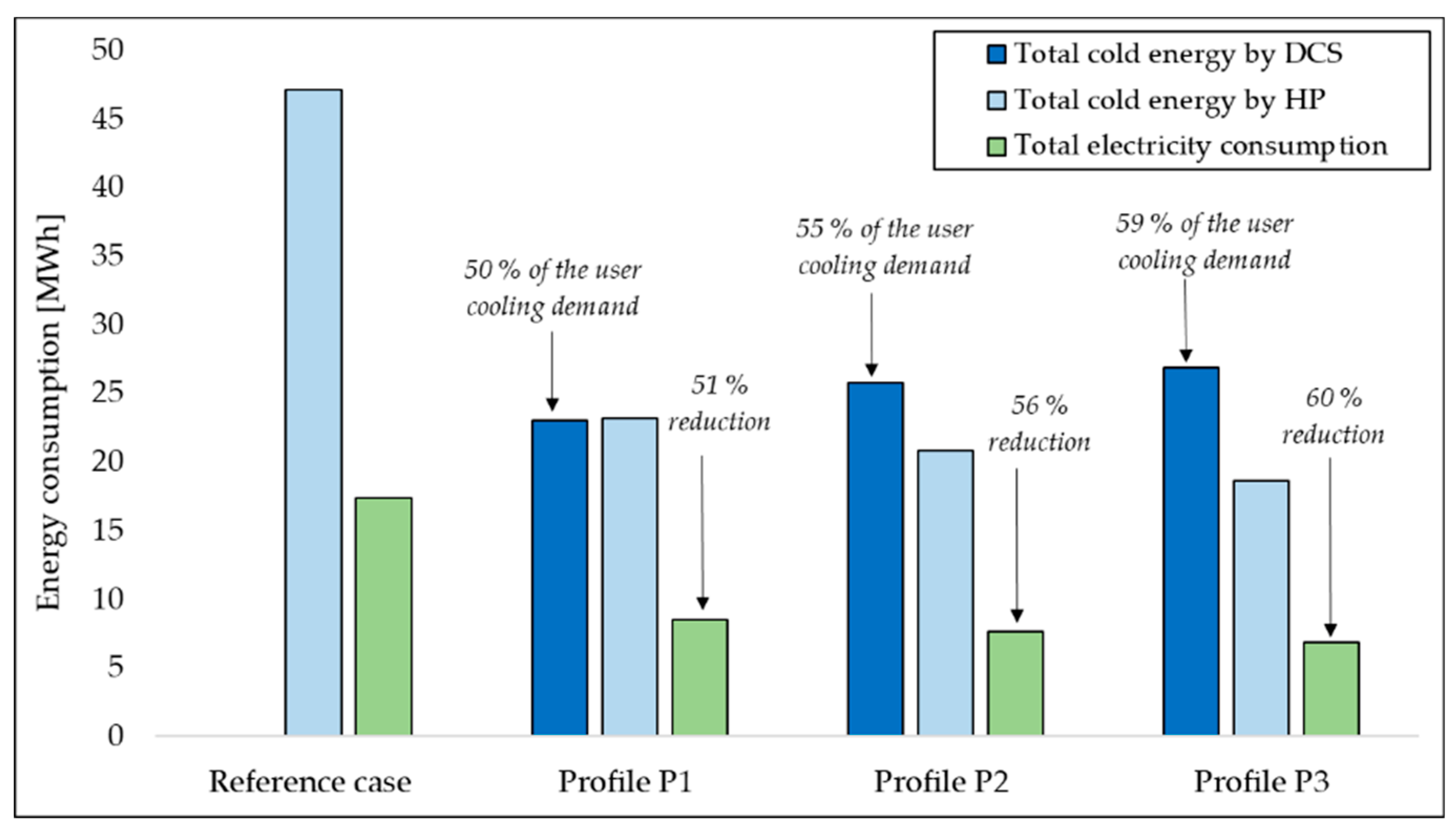
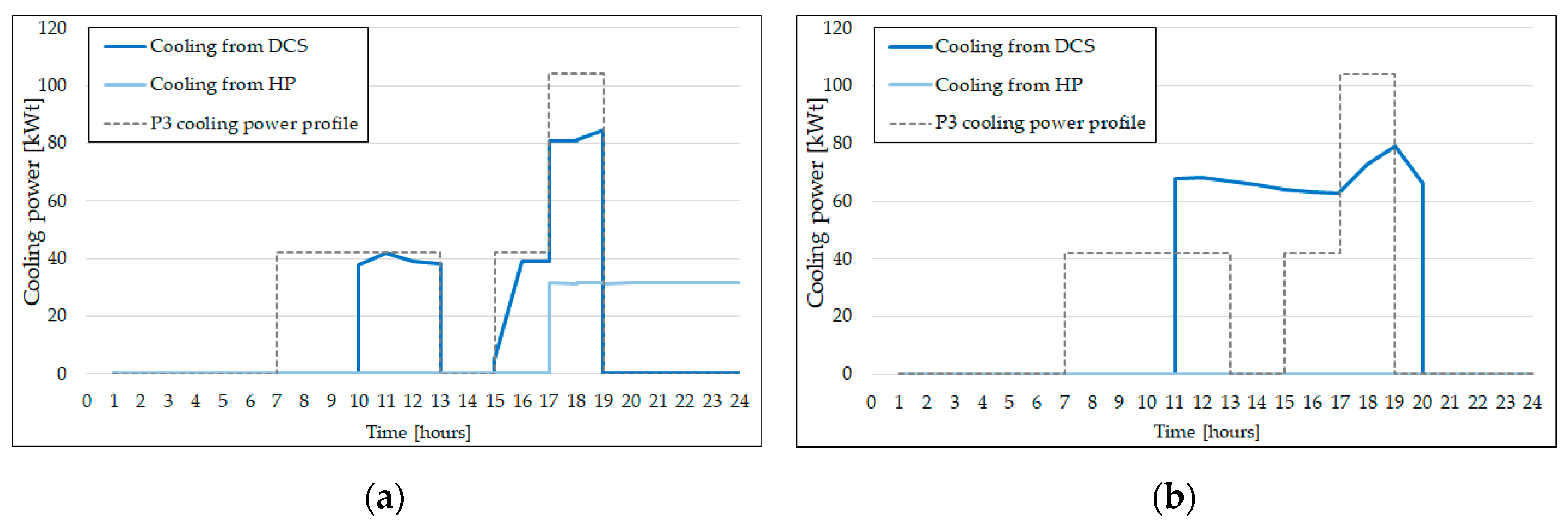

© 2019 by the authors. Licensee MDPI, Basel, Switzerland. This article is an open access article distributed under the terms and conditions of the Creative Commons Attribution (CC BY) license (http://creativecommons.org/licenses/by/4.0/).
Share and Cite
Mugnini, A.; Coccia, G.; Polonara, F.; Arteconi, A. Potential of District Cooling Systems: A Case Study on Recovering Cold Energy from Liquefied Natural Gas Vaporization. Energies 2019, 12, 3027. https://doi.org/10.3390/en12153027
Mugnini A, Coccia G, Polonara F, Arteconi A. Potential of District Cooling Systems: A Case Study on Recovering Cold Energy from Liquefied Natural Gas Vaporization. Energies. 2019; 12(15):3027. https://doi.org/10.3390/en12153027
Chicago/Turabian StyleMugnini, Alice, Gianluca Coccia, Fabio Polonara, and Alessia Arteconi. 2019. "Potential of District Cooling Systems: A Case Study on Recovering Cold Energy from Liquefied Natural Gas Vaporization" Energies 12, no. 15: 3027. https://doi.org/10.3390/en12153027
APA StyleMugnini, A., Coccia, G., Polonara, F., & Arteconi, A. (2019). Potential of District Cooling Systems: A Case Study on Recovering Cold Energy from Liquefied Natural Gas Vaporization. Energies, 12(15), 3027. https://doi.org/10.3390/en12153027






